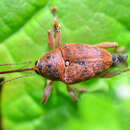en
names in breadcrumbs


Der Eichelbohrer oder Gewöhnliche Eichelbohrer (Curculio glandium) ist ein Käfer aus der Familie der Rüsselkäfer (Curculionidae).
Die Käfer werden 4 bis 7,5 Millimeter lang. Ihr Körper ist mit länglichen, gelbbraunen oder rotbraunen, anliegenden Schuppen bedeckt. Sie sehen den nah verwandten Arten der Gattung sehr ähnlich. Vom Haselnussbohrer (Curculio nucum) unterscheiden sie sich durch die Form der Fühlerglieder und deren Behaarung: Die Geißelglieder sind länger als breit und nur locker, fein anliegend statt abstehend behaart. Außerdem haben sie keinen Haarkamm an der Flügeldeckennaht. Die ebenfalls ähnlichen Arten Curculio venosus und Curculio pellitus unterscheiden sich durch ihr langgestrecktes Schildchen sowohl vom Eichel- als auch vom Haselnussbohrer. Der Rüssel der Männchen ist nur so lang wie die Deckflügel, der der Weibchen ist körperlang.[1]
Die Tiere kommen in ganz Europa, Nordafrika und in der Türkei vor,[2] werden nach Norden hin aber seltener.[3] Sie leben in verschiedenen Lebensräumen mit Gehölzen, wie etwa Wäldern und große Hecken.
Die Weibchen fressen mit ihrem Rüssel tiefe Löcher in unreife Eicheln, um dann ein oder zwei Eier in die Frucht zu legen. Nach etwa zwei Wochen schlüpfen die gelblich weißen, am Kopf rotbraunen, beinlosen Larven. Ihre Lebensweise ähnelt den Larven des Haselnussbohrers. Sie entwickeln sich innerhalb der Frucht und verlassen sie mit einer Körperlänge von 9 bis 10 Millimetern, um etwa 25 Zentimeter tief im Erdboden zu überwintern, bevor sie sich im Frühjahr des nächsten Jahres im Boden verpuppen. Die Imagines der neuen Generation schlüpfen im nächsten Mai oder Juni.
Die Art gilt in Deutschland als ungefährdet.[4]
Der Eichelbohrer oder Gewöhnliche Eichelbohrer (Curculio glandium) ist ein Käfer aus der Familie der Rüsselkäfer (Curculionidae).
Curculio glandium is a species of European carpophagus weevil in the genus Curculio, the acorn and nut weevils.[1] It eats by a rostrum, an elongated snout, that is used for piercing.
Curculio glandium is a member of the genus Curculio, which comprises seed beetles. All members of Curculio have characteristically long rostrums and ovipositors, an adaptation that specifically developed by their reliance on seeds for food and reproduction.[2]
Male/female differentiation can be determined using the rostrum as the female's is longer.[3] The larvae are short, and cylindrical in shape, and move by means of ridges on the underside of the body. Adults can reach a length of 4 to 8 mm (0.16 to 0.31 in).[4]
Curculio glandium eggs are deposited in acorns by the adult weevil chewing channels into the fruit. The eggs are then released using an ovipositor, a long, narrow organ featured in female weevils.[2] These do not reach the acorn's embryo and are healed by the plant, sealing the holes and protecting the eggs from parasites. Upon hatching, either one or two larvae consume the fruit. While they may eat the entirety of the acorn, the larvae typically do not consume the embryo itself.[5] Curculio glandium live throughout winter in the larval stage. The larvae are freeze avoidant, preventing their internal body fluids from freezing during the winter.[6][7]
Curculio glandium can pose a large risk to acorn-bearing tree populations. They are highly effective at infecting acorns which can cause a widespread number of seeds to be incapable of germination, with a potential of rendering 70–90% of seeds incapable of germination.[1][5]
 Adult
Adult Curculio glandium is a species of European carpophagus weevil in the genus Curculio, the acorn and nut weevils. It eats by a rostrum, an elongated snout, that is used for piercing.
Curculio glandium, le charançon du chêne ou balanin du chêne, est une espèce d’insectes coléoptères de la famille des Curculionidae.
Curculio glandium, le charançon du chêne ou balanin du chêne, est une espèce d’insectes coléoptères de la famille des Curculionidae.
Hrastov žižak (žirotoč; Curculio glandium), vrsta štetnog kukca iz porodice pipa (Curculionidae) kojega karakterizira dugo tanko rilo 'rostrum', koje je duže kod ženke, nego kod mužjaka.
Živi po hrastovim šumama a larva se razvija u žiru raznih vrsta hrastova. Ova vrsta najštetnija je među žirotočima i često unište do 70% žira. Jaja u žir polažu početkom srpnja. Ličinka uništava sadržaj žira, a nakon izlaska brzo se zavlače u zemlju gdje se zakukulje. Razvoj do spolno zrelog kukca traje dvije godine.
Hrastov žižak naraste od 4 - 8 mm. Odrasle jedinke se mogu videti od kraja travnja do kraja rujna.
Na Zajedničkom poslužitelju postoje datoteke vezane uz: Hrastov žižak Wikivrste imaju podatke o: Curculio glandiumCurculio glandium é uma espécie de insetos coleópteros polífagos pertencente à família Curculionidae.[1] A autoridade científica da espécie é Marsham, tendo sido descrita no ano de 1802.
Trata-se de uma espécie presente no território português.
Curculio glandium é uma espécie de insetos coleópteros polífagos pertencente à família Curculionidae. A autoridade científica da espécie é Marsham, tendo sido descrita no ano de 1802.
Trata-se de uma espécie presente no território português.
Hrastov semenar (znanstveno ime Curculio glandium) je vrsta pravih rilčkarjev, ki velja za škodljivca v hrastovih gozdovih.[1] Izvira iz Severne Amerike.[2]
Odrasli hrošči dosežejo dolžino od 4 do 8 mm.[3] Značilnost hrastovega semenarja je dolg rilček, ki se pri samicah daljši kot pri samcih [4] in lahko doseže dolžino do 5 mm.[5] Samica na mlade želode odloži eno ali dve jajčeci,[6] iz katerih se izleže valjasta ličinka, ki se nato hrani v notranjosti želoda, vendar običajno ne poje kalčka.[7] Zimo preživijo ličinke znotraj želodov.[8][9]
Hrastov semenar (znanstveno ime Curculio glandium) je vrsta pravih rilčkarjev, ki velja za škodljivca v hrastovih gozdovih. Izvira iz Severne Amerike.